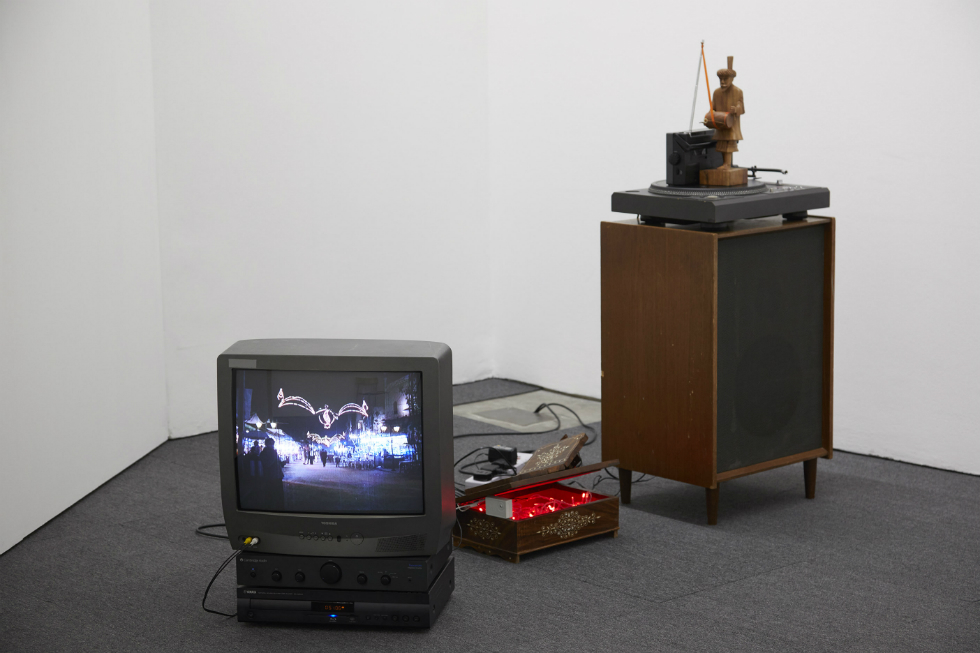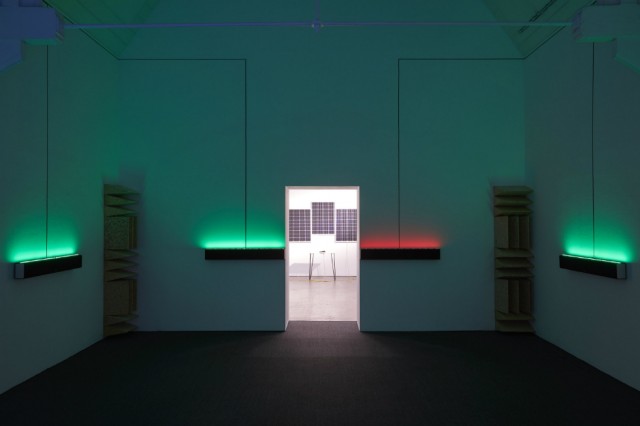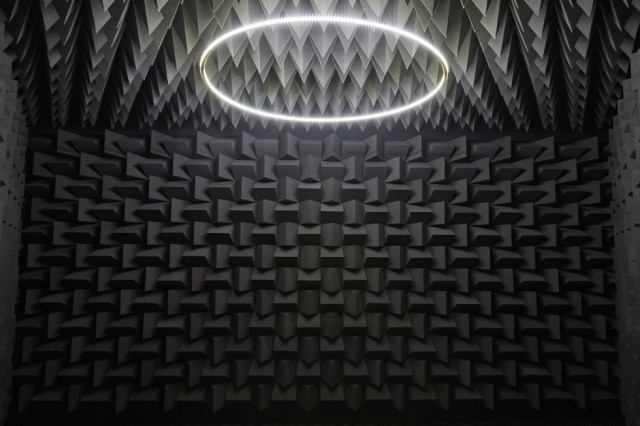“A Skillful Reframing of Reality” Haroon Mirza @ Ikon Gallery – Reviewed

The most comprehensive staging of work by prolific artist Haroon Mirza in the UK so far, Emma Sumner finds an exhibition that suggests more needs to be done – and greater space made – when it comes to presenting a diverse range of artists…
On a chunky old TV, a discerning-seeming customer carefully selects ingredients from a neatly arranged display, before promptly handing them to a street-side chef who expertly chops in a syncopated rhythm with two spatulas. Filmed by Haroon Mirza in Pakistan while exploring his parent’s heritage, the film sits amongst an array of objects – fairy lights, a Koran stand, and a vinyl turntable on which a Sufi statuette spins – that help to reframe this everyday scene. A considered concoction of objects, sound and moving image, Taka Tak (2008) is a perfect example of the early sculptural installations which earned Mirza his stripes.
With an extensive CV peppered with solo shows in assorted institutions and numerous international awards, it is surprising that this small presentation of works drawn from the last 10 years also happens to be the most comprehensive survey of Mirza’s work in the UK to date. Perhaps this highlights a lack of diversity in our galleries, or perhaps a lack of appetite from risk averse institutions to exhibit the work of emerging artists – this is a complex discussion for another article.

Several years in the making, the seamless flow between each mad-professor-esque installation evidences what must have involved hours of considered conversation between Mirza and the exhibition’s curator, Ikon’s director, Jonathan Watkins. Taking art far beyond the visual, each of these installations are fed through the tangle of electrical wires which emerge from the gallery’s crevasses, pumping 50 Hz of electrical energy (the UK’s grid frequency) – the central element in all of Mirza’s work – to emit the pulsating noise or bright lights that gives life to this usually invisible force.
Mirza’s immersive installations have often been interpreted as alternative realities, spaces which remove us from the hum-drum of the everyday, but in fact, each work is a skillful reframing of reality, one exaggerated to a more intense level. Engulfed by multi-coloured lights which grow brighter to the humming crescendo of reverberating noise, A Chamber for Horwitz: Sonakinatography Transcriptions in Surround Sound (2015) draws the viewer into an abstracted version of the night club, a realm from which Mirza, as a DJ, often draws inspiration. Like any good club, the installation’s immersive qualities allow time to stand still, providing much-needed distraction from daily dramas.
Mirza’s hunger for collaboration can be seen throughout the exhibition, particularly in An Infinato (2009), where he re-appropriates edited snippets of Jeremy Deller’s Memory Bucket (2003), and Guy Sherwin’s Cycles (1972/77), alongside his own readymade assemblage combining a piano keyboard, LED light circle and galvanised bin. The playful energy these creative conversations bring to Mirza’s works gives the impression that a day in his studio must be an enjoyable affair, with some of art’s biggest names calling in to collaborate, but Mirza assures, it’s a much more serious affair (most of the time).

The artist’s most recent series, last year’s Rules of Appropriation 1-5, responds to an advertising campaign by the luxury brand, Louis Vuitton (LV), which unashamedly imitated his work without credit. Given his own penchant for creative magpie-ing, Mirza’s honest expression of his difficulties with LV’s use of his work might seem odd; unlike LV, however, his collaborations come from a point of admiration and always seek the permission and input of the artist. As counterfeit LV goods spin on turntables and float above mirror tiles (handbags and wallets, respectively), the work is an interesting variation in Mirza’s oeuvre, and one he describes as still in progress; but it feels unresolved and is perhaps more of a glimpse into his process than the future trajectory of his work.
While this exhibition is a carefully-considered overview of a decade in Mirza’s practice, which directly and intentionally engages with the concept of less being more, I’m left unsatisfied. I do want to see more artwork by this prolific artist, and although this is impossible within the constraints of Ikon’s space, I cannot help but remain frustrated that this is the artist’s biggest exhibition to date. This, however, is perhaps more a reflection on the issue of diversity within our galleries than on this exhibition, which taken on its own terms, is in fact a must-see.
Emma Sumner
Haroon Mirza: reality is somehow what we expect it to be, continues at Ikon Gallery until 24 February
All images courtesy the artist and Ikon; photographs by Stuart Whipps





